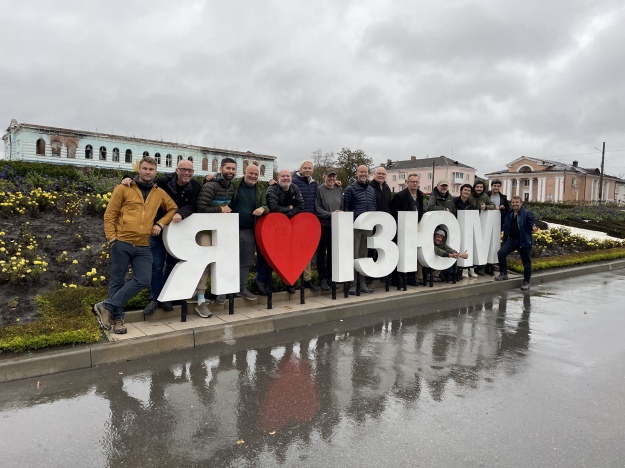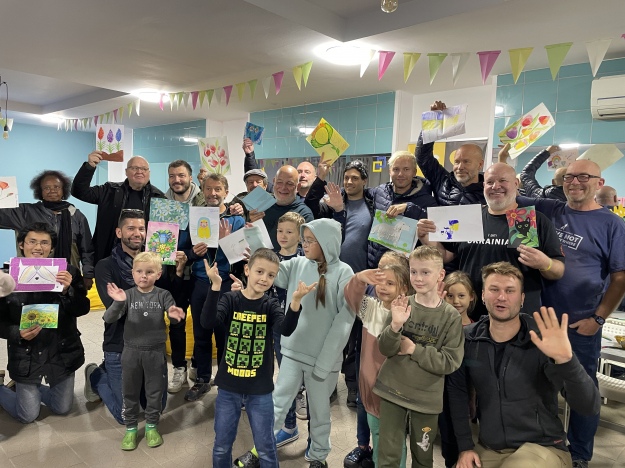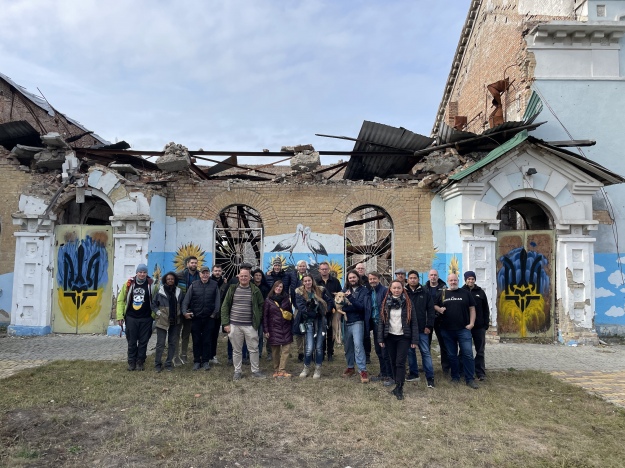Beyond dark tourism: The first traveller group explores Ukraine's former occupied areas
With the carefully planned NomadMania Trip fast approaching, the team was getting more and more anxious. What was their responsibility to travellers joining the tour? What were the ethical implications of visiting a warzone? Were they acting courageously or recklessly? What were their responsibilities to the long-suffering Ukrainian people, was it morally justified to go and observe them?
The Journey into Ukraine's War Zones
They were to become the first group of travellers – not NGO workers, not journalists, not politicians, to visit the areas recently liberated from the Russian occupation. The 'warzone' itinerary included a journey from the relative safety of Lviv to the conflict-ridden areas, such as Kharkiv and Izium. Step two headed to the capital Kyiv and visited the towns of Irpin, Bucha and Borodyanka which were occupied by Russian forces for all of March 2022. Despite the team's concerns, the Kharkiv tour was sold out, indicating that there wasn't a lack of adventure seekers within the NomadMania community. The question remained: did they truly grasp the gravity of their journey?
A Glimpse of Kharkiv
Upon the group's arrival at Kharkiv station, Andrii Nimkovych, representing the local NGO Rescue Now, greeted the group. The main concern was the threat of rocket attacks - it takes merely one minute for a rocket to reach its target when launched from Russian Belgorod, located just across the border. Despite the adrenalin at an all-time high and no room for extended outdoor exploration, their first impressions of Kharkiv were positive, as the city revealed itself as very much alive.
After a quick visit to the local headquarters, travellers joined Rescue Now on their thrice-weekly journey to the East, providing crucial aid to locals who had lost everything in the conflict. The roads leading east of Kharkiv might have been well-paved, but the absence of traffic gave a hint of the region's dark reality.

Delivering Aid in Kamyanka
For safety reasons, the group largely bypassed Izium and headed to nearby Kamyanka. What they found was disheartening. A village without any importance, poor to begin with, had largely been reduced to rubble, the school and hospital destroyed, unusable shells of cars lying at the edge of the dirt roads of this forgettable village. Of a pre-war population of about 1,000, now 70 or so have dared return. Is there any future for a place like this, one wonders? Amidst the devastation, the group helped deliver aid, receiving a warm welcome from the locals, some of whom offered Ukrainian flags as tokens of gratitude.
Exploring Izium
In Izium, the group had two main stops. The local NGO Right Direction, which helps with a whole range of things that locals need given that the government is too busy fighting the war 40 km away, was delighted to give a short city tour of a town. The scars of conflict were evident, with many buildings reduced to rubble. The 'I Love Izium' sign stood as a symbol of hope amid the ruins, and the group posed in support.
The group also paid a meaningful visit to the local women sewing camouflage for the Ukrainian soldiers. Women of all ages, from teenagers to grandmothers, were all working in silence, in unison, each one responsible for a specific task. Mrs. Ira, an elderly lady who had not failed to wear earrings, a bit of mascara and lipstick, was the one most willing to talk. ‘Tell your people Ukraine needs your help,’ she kept on saying. ‘We were living our lives and they came uninvited. We did nothing to provoke them,’ her message continued. These women, who could have chosen to escape and complain, instead displayed resilience and determination, using their skills for the war effort.

Defiance Amidst Destruction
Defiance was a dominant theme, not only in Izium but also in Kharkiv. In front of the shelled Town Council building, right across the square where Lenin once stood, only to be brought down in 2014, there is a bus painted with the word ‘Hugs’, a powerful symbol. Bombings continue, including one near the group's hotel shortly before their arrival. Yet, both the hotel and the city carried on, and many residents had returned, despite closed schools and kindergartens. A visit to the reduced-to-rubble neighbourhood of Saltivka in the northeast was a reminder of the ongoing challenges. This region would likely feature on future 'Dark Tourism' itineraries once air raid alerts were no longer necessary.
The group experienced one such alert as they arrived at the Kharkiv railway station before heading west to Kyiv. It was yet another reminder that dangers persisted and that their feeling of relative safety was far from reality.
During their stay in Kharkiv, travellers visited a basement where about a dozen young children aged 3 to 7 were drawing and being occupied by a group of volunteers. With kindergartens closed, parents who try to live with a semblance of normalcy need some NGOs more than ever. The group gave the children a geography lesson. The children were naturally curious and playful, and the visit was heartwarming.

Down the Ukraine's 'Memory Route'
Kyiv may feel relatively safe, with a busy capital life carrying on as usual. However, the areas close to Kyiv were occupied by Russia for a little over a month in 2022. These small towns form part of what the State Travel Development Agency calls the 'Memory Route.' NomadMania became the first group to pilot the effort to showcase the region's recent history in a meaningful and sober manner. In Irpin, the bridge was destroyed by the Ukrainian army to prevent the Russians from getting to Kyiv. The rubble will be preserved, and a memorial will be built honouring those who perished trying to escape to safety. Irpin had undergone significant rebuilding, showing little evidence of the past, in strong contrast to Kamyanka and even Kharkiv, which seemed to still be in a post-disaster mode.
The Harrowing Tale of Bucha
Bucha was a harrowing experience. The uneasy feeling was not due to the place itself but because of the photos depicting the early days of liberation that the group witnessed within the Orthodox Church of the town. The Vice Mayor's account of the 33-day Russian occupation and how a quarter of the remaining population had mercilessly been executed marked one of the most challenging moments of the trip. Despite this, Bucha, like Irpin, is much rebuilt, unlike Borodyanka further west, where such efforts at reconstruction have not yet started fully. The ‘Memory Route’ ended with a Banksy painting by a bombed-out block and a tour of a makeshift ‘war museum’. The exhibit showcased the horrors that the locals were subjected to and commemorated those from the community who didn’t make it. A local historian has written a book about the occupation. Half the group wanted to purchase a copy in solidarity.
It only took five days for nearly everybody on board to feel like an honorary Ukrainian. Despite the grim context, the warmth and hospitality of the locals were a sign that such visits were more of a much-needed journey into the light, a ray of hope in moments of despair. The exploration of the 'Memory Route' was a unique perspective on the aftermath of conflict. The trip was a testament to human resilience, compassion, and hope, even in the most challenging of circumstances. Those with non-Ukrainian passports, who could leave as needed, became aware of their good fortune and privilege, realising the importance of the fight for freedom.

About Author: Harry Mitsidis, born in 1972 in London, U.K. to a Greek father and a South African mother, is a globetrotter and founder of NomadMania. With a background in sociology and a passion for aviation and film, he initially pursued a career in academia before realizing his true calling. By the age of 36, Harry visited every country recognized by the United Nations, with Equatorial Guinea as his final destination. Inspired by his global adventures, he founded the travel platform TBT, later rebranded as NomadMania in 2017, gathering the world's adventurers. Harry continues to manage this project, while simultaneously pursuing his passion for travel by exploring as many of the 1301 regions featured on NomadMania.
